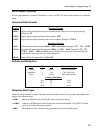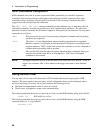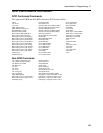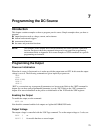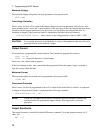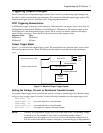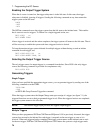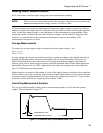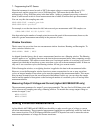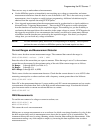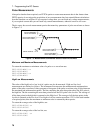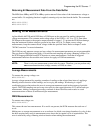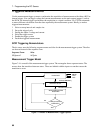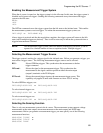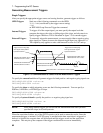
Programming the DC Source - 7
75
Making Basic Measurements
All dc sources have excellent output voltage and current measurement capability.
NOTE: There is only one measurement system in the dc source. Therefore, you can perform only
one measurement function (voltage, current, or DVM) at a time.
All measurements are performed by digitizing the instantaneous output voltage or current for a defined
number of samples and sample interval, storing the results in a buffer, and then calculating the measured
result. For the main output (output 1), many parameters of the measurement are programmable. These
include the number of samples, the time interval between samples, and the method of triggering. Note
that there is a tradeoff between these parameters and the speed, accuracy, and stability of the
measurement in the presence of noise.
Average Measurements
To measure the average output voltage or current for the main output (output 1), use:
MEAS:VOLT?
MEAS:CURR?
Average voltage and current is measured by acquiring a number of readings at the selected time interval,
applying the Hanning window function to the readings, and averaging the readings. Windowing is a
signal conditioning process that reduces the error in average measurements made in the presence of
periodic signals such as pulse current waveforms, which are generated when TDMA cellular phones are
transmitting. The power-on and *RST sample interval and sweep size settings yield a data acquisition
time of 32 milliseconds per measurement.
Ripple rejection is a function of the number of cycles of the ripple frequency contained in the acquisition
window. More cycles in the acquisition window results in better ripple rejection. If you increase the data
acquisition time for each measurement to 45 microseconds for example, this results in 5.53 cycles in the
acquisition window at 60 Hz, for a ripple rejection of about 70 dB.
Controlling Measurement Samples
You can vary both the number of data points in a measurement sample, as well as the time between
samples. This is illustrated in Figure 7-2.
SENS:SWE:POIN
<
# of points>
SENS:SWE:TINT
<
time
>
Figure 7-2. Commands that Control Measurement Time



